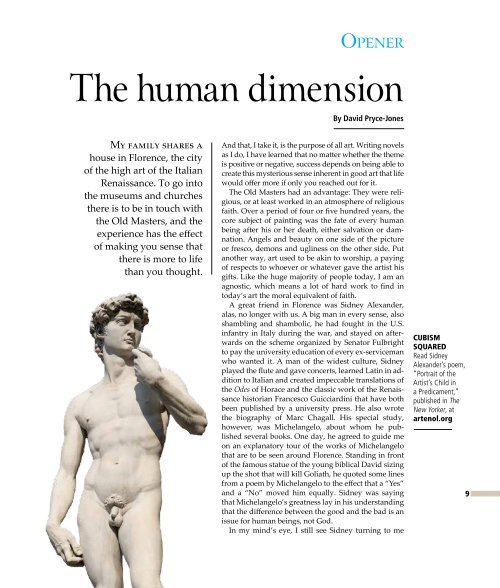artenol0416_sm_flipbook
You also want an ePaper? Increase the reach of your titles
YUMPU automatically turns print PDFs into web optimized ePapers that Google loves.
Opener<br />
The human dimension<br />
By David Pryce-Jones<br />
My family shares a<br />
house in Florence, the city<br />
of the high art of the Italian<br />
Renaissance. To go into<br />
the museums and churches<br />
there is to be in touch with<br />
the Old Masters, and the<br />
experience has the effect<br />
of making you sense that<br />
there is more to life<br />
than you thought.<br />
And that, I take it, is the purpose of all art. Writing novels<br />
as I do, I have learned that no matter whether the theme<br />
is positive or negative, success depends on being able to<br />
create this mysterious sense inherent in good art that life<br />
would offer more if only you reached out for it.<br />
The Old Masters had an advantage: They were religious,<br />
or at least worked in an atmosphere of religious<br />
faith. Over a period of four or five hundred years, the<br />
core subject of painting was the fate of every human<br />
being after his or her death, either salvation or damnation.<br />
Angels and beauty on one side of the picture<br />
or fresco, demons and ugliness on the other side. Put<br />
another way, art used to be akin to worship, a paying<br />
of respects to whoever or whatever gave the artist his<br />
gifts. Like the huge majority of people today, I am an<br />
agnostic, which means a lot of hard work to find in<br />
today’s art the moral equivalent of faith.<br />
A great friend in Florence was Sidney Alexander,<br />
alas, no longer with us. A big man in every sense, also<br />
shambling and shambolic, he had fought in the U.S.<br />
infantry in Italy during the war, and stayed on afterwards<br />
on the scheme organized by Senator Fulbright<br />
to pay the university education of every ex-serviceman<br />
who wanted it. A man of the widest culture, Sidney<br />
played the flute and gave concerts, learned Latin in addition<br />
to Italian and created impeccable translations of<br />
the Odes of Horace and the classic work of the Renaissance<br />
historian Francesco Guicciardini that have both<br />
been published by a university press. He also wrote<br />
the biography of Marc Chagall. His special study,<br />
however, was Michelangelo, about whom he published<br />
several books. One day, he agreed to guide me<br />
on an explanatory tour of the works of Michelangelo<br />
that are to be seen around Florence. Standing in front<br />
of the famous statue of the young biblical David sizing<br />
up the shot that will kill Goliath, he quoted some lines<br />
from a poem by Michelangelo to the effect that a “Yes”<br />
and a “No” moved him equally. Sidney was saying<br />
that Michelangelo’s greatness lay in his understanding<br />
that the difference between the good and the bad is an<br />
issue for human beings, not God.<br />
In my mind’s eye, I still see Sidney turning to me<br />
CUBISM<br />
SQUARED<br />
Read Sidney<br />
Alexander’s poem,<br />
“Portrait of the<br />
Artist’s Child in<br />
a Predicament,”<br />
published in The<br />
New Yorker, at<br />
artenol.org<br />
9

















